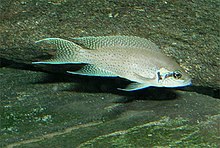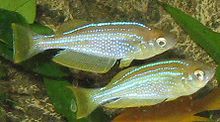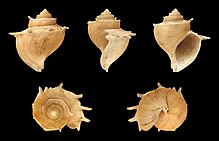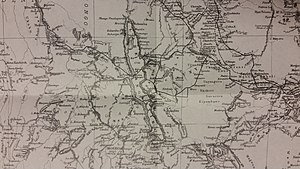| Lake Tanganyika | |
|---|---|

Lake Tanganyika from space, June 1985
| |
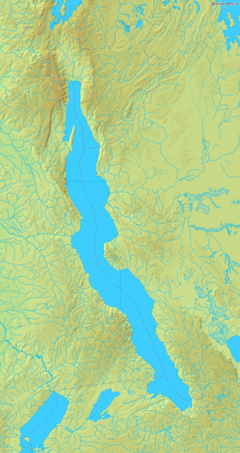
Lake Tanganyika map
| |
| Coordinates | 6°30′S 29°50′ECoordinates: 6°30′S 29°50′E |
| Lake type | Ancient lake, Rift Valley Lake |
| Primary inflows | Ruzizi River Malagarasi River Kalambo River |
| Primary outflows | Lukuga River |
| Catchment area | 231,000 km2 (89,000 sq mi) |
| Basin countries | Burundi East Congo (DRC) Tanzania Zambia |
| Max. length | 673 km (418 mi) |
| Max. width | 72 km (45 mi) |
| Surface area | 32,900 km2 (12,700 sq mi) |
| Average depth | 570 m (1,870 ft) |
| Max. depth | 1,470 m (4,820 ft) |
| Water volume | 18,900 km3 (4,500 cu mi) |
| Residence time | 5500 years |
| Shore length1 | 1,828 km (1,136 mi) |
| Surface elevation | 773 m (2,536 ft) |
| Settlements | Kigoma, Tanzania Kalemie, DRC Bujumbura, Burundi |
| Official name | Tanganyika |
| Designated | 2 February 2007 |
| Reference no. | 1671 |
| 1 Shore length is not a well-defined measure. | |
Lake Tanganyika is an African Great Lake. It is the second-oldest freshwater lake in the world, the second-largest by volume, and the second-deepest, in all cases after Lake Baikal in Siberia. It is the world's longest freshwater lake. The lake is shared between four countries – Tanzania, the Democratic Republic of the Congo (DRC), Burundi, and Zambia, with Tanzania (46%) and DRC (40%) possessing the majority of the lake. It drains into the Congo River system and ultimately into the Atlantic Ocean.
Etymology
The name "Tanganyika" apparently refers to "the great lake spreading out like a plain", or "plain-like lake".
Geography and geological history
Lake Tanganyika is situated within the Albertine Rift, the western branch of the East African Rift, and is confined by the mountainous walls of the valley. It is the largest rift lake
in Africa and the second-largest lake by volume in the world. It is the
deepest lake in Africa and holds the greatest volume of fresh water,
accounting for 16% of the world's available fresh water. It extends for
676 km (420 mi) in a general north-south direction and averages 50 km
(31 mi) in width. The lake covers 32,900 km2 (12,700 sq mi),
with a shoreline of 1,828 km (1,136 mi), a mean depth of 570 m
(1,870 ft) and a maximum depth of 1,471 m (4,826 ft) (in the northern
basin). It holds an estimated 18,900 cubic kilometres (4,500 cu mi).
The catchment area of the lake is 231,000 km2
(89,000 sq mi). Two main rivers flow into the lake, as well as numerous
smaller rivers and streams (whose lengths are limited by the steep
mountains around the lake). The one major outflow is the Lukuga River, which empties into the Congo River
drainage. Precipation and evaporation play a greater role than the
rivers. At least 90% of the water influx is from rain falling on the
lake's surface and at least 90% of the water loss is from direct
evaporation.
The major river flowing into the lake is the Ruzizi River, formed about 10,000 years ago, which enters the north of the lake from Lake Kivu. The Malagarasi River, which is Tanzania's second largest river, enters the east side of Lake Tanganyika. The Malagarasi is older than Lake Tanganyika, and before the lake was formed, it probably was a headwater of the Lualaba River, the main Congo River headstream.
The lake has a complex history of changing flow patterns, due to
its high altitude, great depth, slow rate of refill, and mountainous
location in a turbulently volcanic area that has undergone climate
changes. Apparently, it has rarely in the past had an outflow to the
sea. It has been described as "practically endorheic"
for this reason. The lake's connection to the sea is dependent on a
high water level allowing water to overflow out of the lake through the
Lukuga River into the Congo.
When not overflowing, the lake's exit into the Lukuga River typically
is blocked by sand bars and masses of weed, and instead this river
depends on its own tributaries, especially the Niemba River, to maintain
a flow.
Due to the lake's tropical location, it has a high rate of
evaporation. Thus, it depends on a high inflow through the Ruzizi out of
Lake Kivu to keep the lake high enough to overflow. This outflow is
apparently not more than 12,000 years old, and resulted from lava flows
blocking and diverting the Kivu basin's previous outflow into Lake Edward
and then the Nile system, and diverting it to Lake Tanganyika. Signs of
ancient shorelines indicate that at times, Tanganyika may have been up
to 300 m (980 ft) lower than its present surface level, with no outlet
to the sea. Even its current outlet is intermittent, thus may not have
been operating when first visited by Western explorers in 1858.
The lake may also have at times had different inflows and outflows; inward flows from a higher Lake Rukwa, access to Lake Malawi and an exit route to the Nile have all been proposed to have existed at some point in the lake's history.
Lake Tanganyika is an ancient lake.
Its three basins, which in periods with much lower water levels were
separate lakes, are of different ages. The central began to form 9–12
million years ago (Mya), the northern 7–8 Mya and the southern 2–4 Mya.
Islands
Of the several islands in Lake Tanganyika, the most important are:
- Kavala Island (DRC)
- Mamba-Kayenda Islands (DRC)
- Milima Island (DRC)
- Kibishie Island (DRC)
- Mutondwe Island (Zambia)
- Kumbula Island (Zambia)
Water characteristics
The lake's water is alkaline with a pH around 9 at depths of 0–100 m (0–330 ft). Below this, it is around 8.7, gradually decreasing to 8.3–8.5 in the deepest parts of Tanganyika. A similar pattern can be seen in the electric conductivity, ranging from about 670 μS/cm in the upper part to 690 μS/cm in the deepest.
Surface temperatures generally range from about 24 °C (75 °F) in
the southern part of the lake in early August to 28–29 °C (82–84 °F) in
the late rainy season in March—April. At depths greater than 400 m (1,300 ft), the temperature is very stable at 23.1–23.4 °C (73.6–74.1 °F). The water has gradually warmed since the 1800s and this has accelerated with global warming since the 1950s.
The lake is stratified and seasonal mixing generally does not extend beyond depths of 150 m (490 ft). The mixing mainly occurs as upwellings in the south and is wind-driven, but to a lesser extent, up- and downwellings also occur elsewhere in the lake. As a consequence of the stratification, the deep sections contain "fossil water". This also means it has no oxygen (it is anoxic) in the deeper parts, essentially limiting fish and other aerobic organisms
to the upper part. Some geographical variations are seen in this limit,
but it is typically at depths around 100 m (330 ft) in the northern
part of the lake and 240–250 m (790–820 ft) in the south. The oxygen-devoid deepest sections contain high levels of toxic hydrogen sulphide and are essentially lifeless, except for bacteria.
Biology
Reptiles
Lake Tanganyika and associated wetlands are home to Nile crocodiles (including famous giant Gustave), Zambian hinged terrapins, serrated hinged terrapins, and pan hinged terrapins (last species not in the lake itself, but in adjacent lagoons). Storm's water cobra, a threatened subspecies of banded water cobra that feeds mainly on fish, is only found in Lake Tanganyika, where it prefers rocky shores.
Cichlid fish
One of the many Tanganyika cichlids is Neolamprologus brichardi. The complex behaviors of this species and its close relative N. pulcher have been studied in detail
The lake holds at least 250 species of cichlid fish and undescribed species remain. Almost all (98%) of the Tanganyika cichlids are endemic to the lake and it is thus an important biological resource for the study of speciation in evolution.
Some of the endemics do occur slightly into the upper Lukuga River,
Lake Tanganyika's outflow, but further spread into the Congo River basin
is prevented by physics (Lukuga has fast-flowing sections with many
rapids and waterfalls) and chemistry (Tanganyika's water is alkaline, while the Congo's generally is acidic). The cichlids of the African Great Lakes, including Tanganyika, represent the most diverse extent of adaptive radiation in vertebrates.
Although Tanganyika has far fewer cichlid species than Lakes Malawi and Victoria which both have experienced relatively recent explosive species radiations (resulting in many closely related species), its cichlids are the most morphologically and genetically diverse. This is linked to the high age of Tanganyika, as it is far older than the other lakes. Tanganyika has the largest number of endemic cichlid genera of all African lakes. All Tanganyika cichlids are in the subfamily Pseudocrenilabrinae. Of the 10 tribes in this subfamily, half are largely or entirely restricted to the lake (Cyprichromini, Ectodini, Lamprologini, Limnochromini and Tropheini) and another three have species in the lake (Haplochromini, Tilapiini and Tylochromini). Others have proposed splitting the Tanganyika cichlids into as many as 12–16 tribes (in addition to previous mentioned, Bathybatini, Benthochromini, Boulengerochromini, Cyphotilapiini, Eretmodini, Greenwoodochromini, Perissodini and Trematocarini).
Most Tanganyika cichlids live along the shoreline down to a depth
of 100 m (330 ft), but some deep-water species regularly descend to
200 m (660 ft). Trematocara species have exceptionally been found at more than 300 m (980 ft), which is deeper than any other cichlid in the world. Some of the deep-water cichlids (e.g., Bathybates, Gnathochromis, Hemibates and Xenochromis) have been caught in places virtually devoid of oxygen, but how they are able to survive there is unclear. Tanganyika cichlids are generally benthic (found at or near the bottom) and/or coastal. No Tanganyika cichlids are truly pelagic and offshore, except for some of the piscivorous Bathybates. Two of these, B. fasciatus and B. leo, mainly feed on Tanganyika sardines. Tanganyika cichlids differ extensively in ecology and include species that are herbivores, detritivores, planktivores, insectivores, molluscivores, scavengers, scale-eaters and piscivores. Their breeding behavior fall into two main groups, the substrate spawners (often in caves or rock crevices) and the mouthbrooders. Among the endemic species are two of the world's smallest cichlids, Neolamprologus multifasciatus and N. similis (both shell dwellers) at up to 4–5 cm (1.6–2.0 in), and one of the largest, the giant cichlid (Boulengerochromis microlepis) at up to 90 cm (3.0 ft).
Many cichlids from Lake Tanganyika, such as species from the genera Altolamprologus, Cyprichromis, Eretmodus, Julidochromis, Lamprologus, Neolamprologus, Tropheus and Xenotilapia, are popular aquarium fish due to their bright colors and patterns, and interesting behaviors. Recreating a Lake Tanganyika biotope to host those cichlids in a habitat similar to their natural environment is also popular in the aquarium hobby.
Other fish
The Tanganyika killifish (Lamprichthys tanganicanus) is the only member of its genus
Lake Tanganyika is home to more than 80 species of non-cichlid fish and about 60% of these are endemic.
The open waters of the pelagic zone are dominated by four non-cichlid species: Two species of "Tanganyika sardine" (Limnothrissa miodon and Stolothrissa tanganicae) form the largest biomass of fish in this zone, and they are important prey for the forktail lates (Lates microlepis) and sleek lates (L. stappersii). Two additional lates are found in the lake, the Tanganyika lates (L. angustifrons) and bigeye lates (L. mariae), but both these are primarily benthic hunters, although they also may move into open waters. The four lates, all endemic to Tanganyika, have been overfished and larger individuals are rare today.
Among the more unusual fish in the lake are the endemic, facultatively brood parasitic "cuckoo catfish", including at least Synodontis grandiops and S. multipunctatus. A number of others are very similar (e.g., S. lucipinnis and S. petricola) and have often been confused; it is unclear if they have a similar behavior.
The facultative brood parasites often lay their eggs synchronously with
mouthbroding cichlids. The cichlid pick up the eggs in their mouth as
if they were their own. Once the catfish eggs hatch the young eat the
cichlid eggs. Six catfish genera are entirely restricted to the lake basin: Bathybagrus, Dinotopterus, Lophiobagrus, Phyllonemus, Pseudotanganikallabes and Tanganikallabes. Although not endemic on a genus level, six species of Chrysichthys catfish are only found in the Tanganyika basin where they live both in shallow and relatively deep waters; in the latter habitat they are the primary predators and scavengers. A unique evolutionary radiation in the lake is the 15 species of Mastacembelus spiny eels, all but one endemic to its basin. Although other African Great Lakes have Synodontis catfish, endemic catfish genera and Mastacembelus spiny eels, the relatively high diversity is unique to Tanganyika, which likely is related to its old age.
Among the non-endemic fish, some are widespread African species
but several are only shared with the Malagarasi and Congo River basins,
such as the Congo bichir (Polypterus congicus), goliath tigerfish (Hydrocynus goliath), Citharinus citharus, six-banded distichodus (Distichodus sexfasciatus) and mbu puffer (Tetraodon mbu).[50]
Molluscs and crustaceans
The shell of the endemic thalassoid freshwater snail Tiphobia horei with its elaborate shape and spines.
A total of 83 freshwater snail species (65 endemic) and 11 bivalve species (8 endemic) are known from the lake. Among the endemic bivalves are three monotypic genera: Grandidieria burtoni, Pseudospatha tanganyicensis and Brazzaea anceyi. Many of the snails are unusual for species living in freshwater in having noticeably thickened shells and/or distinct sculpture, features more commonly seen in marine snails. They are referred to as thalassoids, which can be translated to "marine-like". All the Tanganyika thalassoids, which are part of Prosobranchia, are endemic to the lake.
Initially they were believed to be related to similar marine snails,
but they are now known to be unrelated. Their appearance is now believed
to be the result of the highly diverse habitats in Lake Tanganyika and evolutionary pressure from snail-eating fish and, in particular, Platythelphusa crabs. A total of 17 freshwater snail genera are endemic to the lake, such as Hirthia, Lavigeria, Paramelania, Reymondia, Spekia, Stanleya, Tanganyicia and Tiphobia. There are about 30 species of non-thalassoid snails in the lake, but only five of these are endemic, including Ferrissia tanganyicensis and Neothauma tanganyicense. The latter is the largest Tanganyika snail and its shell is often used by small shell-dwelling cichlids.
Crustaceans are also highly diverse in Tanganyika with more than 200 species, of which more than half are endemic. They include 10 species of freshwater crabs (9 Platythelphusa and Potamonautes platynotus; all endemic), at least 11 species of small atyid shrimp (Atyella, Caridella and Limnocaridina), an endemic palaemonid shrimp (Macrobrachium moorei), about 100 ostracods, including many endemics, and several copepods. Among these, Limnocaridina iridinae lives inside the mantle cavity of the unionid mussel Pleiodon spekei, making it one of only two known commensal species of freshwater shrimp (the other is the sponge-living Caridina spongicola from Lake Towuti, Indonesia).
Among Rift Valley lakes,
Lake Tanganyika far surpasses all others in terms of crustacean and
freshwater snail richness (both in total number of species and number of
endemics).
For example, the only other Rift Valley lake with endemic freshwater
crabs are Lake Kivu and Lake Victoria with two species each.
Other invertebrates
The
diversity of other invertebrate groups in Lake Tanganyika is often not
well-known, but there are at least 20 described species of leeches (12 endemics), 9 sponges (7 endemic), 6 bryozoa (2 endemic), 11 flatworms (7 endemic), 20 nematodes (7 endemic), 28 annelids (17 endemic) and the small hydrozoan jellyfish Limnocnida tanganyicae.
Fishing
Fishermen on Lake Tanganyika
Lake Tanganyika supports a major fishery, which, depending on source, provides 25–40% or c. 60% of the animal protein in the diet of the people living in the region.
Currently, there are around 100,000 people directly involved in the
fisheries operating from almost 800 sites. The lake is also vital to the
estimated 10 million people living in the greater basin.
Lake Tanganyika fish can be found exported throughout East
Africa. Major commercial fishing began in the mid-1950s and has,
together with global warming (limiting the habitat of temperature
sensitive species), had a heavy impact on the fish populations, causing
significant declines. In 2016, it was estimated that the total catch was up to 200,000 tonnes. Former industrial fisheries, which boomed in the 1980s, have subsequently collapsed.
Transport
Two ferries carry passengers and cargo along the eastern shore of the lake: MV Liemba between Kigoma and Mpulungu and MV Mwongozo between Kigoma and Bujumbura.
- The port town of Kigoma is the railhead for the railway from Dar es Salaam in Tanzania.
- The port town of Kalemie (previously named Albertville) is the railhead for the D.R. Congo rail network.
- The port town of Mpulungu is a proposed railhead for Zambia.
On Dec. 12, 2014, the ferry MV Mutambala capsized on Lake Tanganyika, and more than 120 lives were lost.
History
Lake Tanganyika. The black line indicates Henry Morton Stanley's route.
It is thought that early Homo sapiens were making an impact on the region during the stone age.
The time period of the Middle Stone Age to Late Stone Age is described
as an age of advanced hunter-gatherers. It is believed they would have
caused megafaunal extinctions.
There are many methods in which the native people of the area
were fishing. Most of them included using a lantern as a lure for fish
that are attracted to light. There were three basic forms. One called
Lusenga which is a wide net used by one person from a canoe. The second
one is using a lift net. This was done by dropping a net deep below the
boat using two parallel canoes and then simultaneously pulling it up.
The third is called Chiromila which consisted of three canoes. One canoe
was stationary with a lantern while another canoe holds one end of the
net and the other circles the stationary one to meet up with the net.
The first known Westerners to find the lake were the British explorers Richard Burton and John Speke, in 1858. They located it while searching for the source of the Nile River. Speke continued and found the actual source, Lake Victoria. Later David Livingstone passed by the lake. He noted the name "Liemba" for its southern part, a word probably from the Fipa language, and in 1927 this was chosen as the new name for the conquered German First World War ship Graf von Götzen which is still serving the lake up to the present time.
World War I
The lake was the scene of two celebrated battles during World War I.
With the aid of the Graf Goetzen (named after Count Gustav Adolf Graf von Götzen, the former governor of German East Africa),
the Germans had complete control of the lake in the early stages of the
war. The ship was used both to ferry cargo and personnel across the
lake, and as a base from which to launch surprise attacks on Allied
troops.
It therefore became essential for the Allied forces to gain
control of the lake themselves. Under the command of Lieutenant
Commander Geoffrey Spicer-Simson the British Royal Navy achieved the monumental task of bringing two armed motor boats HMS Mimi and HMS Toutou from England to the lake by rail, road and river to Albertville (since renamed Kalemie
in 1971) on the western shore of Lake Tanganyika. The two boats waited
until December 1915, and mounted a surprise attack on the Germans, with
the capture of the gunboat Kingani. Another German vessel, the Hedwig, was sunk in February 1916, leaving the Götzen as the only German vessel remaining to control the lake.
As a result of their strengthened position on the lake, the
Allies started advancing towards Kigoma by land, and the Belgians
established an airbase on the western shore at Albertville. It was from
there, in June 1916, that they launched a bombing raid on German
positions in and around Kigoma. It is unclear whether or not the Götzen
was hit (the Belgians claimed to have hit it but the Germans denied
this), but German morale suffered and the ship was subsequently stripped
of its gun since it was needed elsewhere.
The war on the lake had reached a stalemate by this stage, with
both sides refusing to mount attacks. However, the war on land was
progressing, largely to the advantage of the Allies, who cut off the
railway link in July 1916 and threatened to isolate Kigoma completely.
This led the German commander, Gustav Zimmer,
to abandon the town and head south. In order to avoid his prize ship
falling into Allied hands, Zimmer scuttled the vessel on July 26, 1916.
The vessel was later raised in 1924 and renamed MV Liemba (see transport).
Che Guevara
In 1965 Argentinian revolutionary Che Guevara
used the western shores of Lake Tanganyika as a training camp for
guerrilla forces in the Congo. From his camp, Che and his forces
attempted to overthrow the government, but ended up pulling out in less
than a year since the National Security Agency (NSA) had been monitoring him the entire time and aided government forces in ambushing his guerrillas.
Recent history
In 1992 Lake Tanganyika featured in the British TV documentary series Pole to Pole. The BBC documentarian Michael Palin stayed on board the MV Liemba and travelled across the lake.
Since 2004 the lake has been the focus of a massive Water and Nature Initiative by the IUCN.
The project is scheduled to take five years at a total cost of US$27
million. The initiative is attempting to monitor the resources and state
of the lake, set common criteria for acceptable level of sediments,
pollution, and water quality in general, and design and establish a lake
basin management authority.
Effects of global warming
Because of increasing global temperature there is a direct correlation to lower productivity in Lake Tanganyika.
Southern winds create upwells of deep nutrient-rich water on the
southern end of the lake. This happens during the cooler months (May to
September). These nutrients that are in deep water are vital in
maintaining the aquatic food web.
The southerly winds are slowing down which limits the ability for the
mixing of nutrients. This is correlating with less productivity in the
lake.
Alleged Fijian connection
According to a legend of the indigenous people from some parts of the Fiji
islands in the South Pacific Ocean, the Fijians originated from
Tanganyika. This myth is thought to have originated in relatively recent
decades. However, this hypothesis is not tenable and is contradicted by archaeological, linguistic and genetic evidence.

